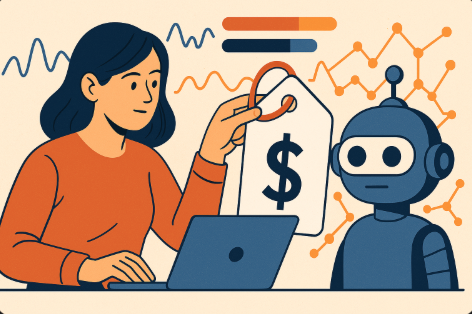Pricing is no longer a fixed or predictable factor in today’s fast-moving digital world,. Prices are constantly changing, driven by a range of elements, from demand and time to location, weather, and more. The emergence of dynamic pricing, a tactic that uses complex algorithms to modify prices in real-time, is mostly responsible for this change.
However, this raises the question of who is actually responsible for the cost that we ultimately incur. Is it artificial intelligence, the company's owners, or something else? It's crucial to learn more about the workings of dynamic pricing and how artificial intelligence shapes the prices we see on a daily basis in order to provide a response.
A Look at Dynamic Pricing
Dynamic pricing, also known as surge or demand-based pricing, is a strategy where the price of a product or service fluctuates in response to real-time supply and demand. This model is widely applied across various sectors, from airlines to ride-sharing services, and even retail.
Take ride-sharing apps like Uber, for example. They use algorithms to modify fares based on demand. During high-traffic periods, such as peak hours or during a major event, the cost of a ride will increase to balance supply and demand. Similarly, in the airline industry, ticket prices rise as the flight date nears, or when there are fewer seats left.
The Role of AI in Dynamic Pricing
Before the introduction of AI, businesses would typically set prices manually or rely on broad market trends. But now, with the integration of AI, dynamic pricing has become far more precise and efficient. AI algorithms process vast amounts of data in real-time, helping businesses determine the most appropriate price for a product or service.
These algorithms consider factors such as competitors’ pricing, consumer behavior, market trends, and even external influences. As a result, prices can fluctuate from minute to minute, depending on these constantly changing inputs. For instance, if a competitor drops their price, AI systems can instantly detect that shift and adjust their own prices to stay competitive.
AI’s can also personalize pricing based on individual consumer behavior, such as browsing history, past purchases, or even the device being used. This practice, known as personalized pricing, means that the price you see could be tailored to you personally, potentially offering a deal if you’re a frequent shopper or charging more if you’re seen as a high-value customer.
The Companies behind the Prices
While AI systems are responsible for the heavy lifting when it comes to adjusting prices, businesses still have the final say in how these algorithms operate. Companies decide what goals their AI systems should prioritize, be it maximizing revenue, capturing market share, or clearing out stock, and these objectives help shape how prices are adjusted.
That said, AI systems are not flawless. Their effectiveness is only as good as the data they process. If that data is inaccurate, or if a company’s objectives skew too far toward profit maximization at the expense of fairness, AI-driven pricing could lead to unfair outcomes. For example, a customer might end up paying a higher price simply because of when they make a purchase or their previous buying habits.
Why Personalized Pricing is A Double-Edged Sword
Personalized pricing, while offering a more tailored shopping experience, has stirred up its own set of challenges and ethical dilemmas. This practice involves setting prices based on detailed consumer data, such as previous purchases, browsing habits, or even location. For example, frequent shoppers might get discounts, while new customers or those with a lower purchase history could face higher prices.
On the one hand, personalized pricing can create great deals for loyal customers, but on the other, it can result in significant disparities. Some customers might be charged more for the exact same product or service, simply because of where they live, when they shop, or what they’ve purchased in the past. This discrepancy can create a feeling of unfairness in the marketplace.
The Consumer's Perspective
Dynamic pricing presents a mixed bag for consumers. On the plus side, it can offer lower prices during times of low demand. For instance, hotels, flights, and rental cars may be significantly cheaper during off-peak seasons or if booked well in advance. Consumers who are savvy enough to time their purchases right can take full advantage of these discounts.
However, during periods of high demand, dynamic pricing can work against the consumer, resulting in higher prices. This is especially noticeable in industries like transportation, where ride-sharing services raise their rates during peak hours. The unpredictable nature of dynamic pricing makes it difficult for consumers to know when they’re getting the best deal.
Price comparison websites and browser extensions can help track price history and offer some guidance, but the constantly shifting prices make it nearly impossible to always predict when and at what price point to buy. In the age of AI-driven pricing, consumer feedback has become more crucial than ever. Platforms like Trustfeed, which aggregate customer reviews, give businesses valuable insights into consumer preferences and behavior. This data can help businesses refine their pricing strategies, ensuring they remain competitive while also meeting customer expectations.
